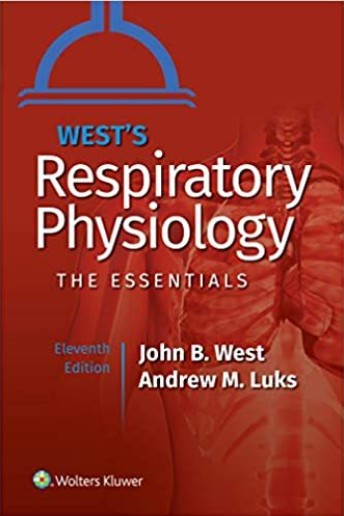
Chapter 1 Structure and Function—How the Architecture of the Lung Subserves Its Function
Blood-Gas Interface
Airways and Airflow
Blood Vessels and Flow
Stability of Alveoli
Removal of Inhaled Particles
Removal of Material from the Blood
Chapter 1: Multiple Choice Questions
Chapter 2 Ventilation—How Gas Gets to the Alveoli
Lung Volumes
Ventilation
Anatomic Dead Space
Physiologic Dead Space
Regional Differences in Ventilation
Chapter 2: Multiple Choice Questions
Chapter 3 Diffusion—How Gas Gets Across the Blood-Gas Barrier
Laws of Diffusion
Diffusion and Perfusion Limitations
Oxygen Uptake Along the Pulmonary Capillary
Measurement of Diffusing Capacity
Reaction Rates with Hemoglobin
Interpretation of Diffusing Capacity for CO
CO2 Transfer Across the Pulmonary Capillary
Chapter 3: Multiple Choice Questions
Chapter 4 Blood Flow and Metabolism—How the Pulmonary Circulation Removes Gas from the Lung and Alters
Some Metabolites
Pressures Within Pulmonary Blood Vessels
Pressures Around Pulmonary Blood Vessels
Pulmonary Vascular Resistance
Measurement of Pulmonary Blood Flow
Distribution of Blood Flow
Active Control of the Circulation
Water Balance in the Lung
Other Functions of the Pulmonary Circulation
Metabolic Functions of the Lung
Chapter 4: Multiple Choice Questions
Chapter 5 Ventilation-Perfusion Relationships—How Matching of Gas and Blood Determines Gas Exchange
더보기
Oxygen Transport from Air to Tissues
Hypoventilation
Diffusion Limitation
Shunt
The Ventilation-Perfusion Ratio
Effect of Altering the Ventilation-Perfusion Ratio of a Lung Unit
Regional Gas Exchange in the Lung
Effect of Ventilation-Perfusion Inequality on Overall Gas Exchange
Distributions of Ventilation-Perfusion Ratios
Ventilation-Perfusion Inequality as a Cause of CO2 Retention
Measurement of Ventilation-Perfusion Inequality
Chapter 5: Multiple Choice Questions
Chapter 6 Gas Transport by the Blood—How Gases Are Moved to and from the Peripheral Tissues
Oxygen
Dissolved O2
Combination with Hemoglobin
O2 Dissociation Curve
Carbon Dioxide
CO2 Carriage
CO2 Dissociation Curve
Acid-Base Status
Respiratory Acidosis
Respiratory Alkalosis
Metabolic Acidosis
Metabolic Alkalosis
Blood-Tissue Gas Exchange
Diffusion
Tissue Po2
Mixed Venous Po2
Chapter 6: Multiple Choice Questions
Chapter 7 Mechanics of Breathing—How the Lung Is Supported and Moved
Muscles of Respiration
Inspiration
Expiration
Elastic Properties of the Lung
Pressure-Volume Curve
Compliance
Surface Tension
Cause of Regional Differences in Ventilation
Airway Closure
Elastic Properties of the Chest Wall
Airway Resistance
Airflow Through Tubes
Measurement of Airway Resistance
Pressures During the Breathing Cycle
Chief Site of Airway Resistance
Factors Determining Airway Resistance
Dynamic Compression of Airways
Forced Expiration Test
Additional Causes of Uneven Ventilation
Tissue Resistance
Work of Breathing
Work Done on the Lung
Total Work of Breathing
Mechanics of Positive Pressure Breathing
Chapter 7: Multiple Choice Questions
Chapter 8 Control of Ventilation—How Gas Exchange Is Regulated
Central Controller
Brainstem
Cortex
Other Parts of the Brain
Effectors
Sensors
Central Chemoreceptors
Peripheral Chemoreceptors
Lung Receptors
Other Receptors
Integrated Responses
Response to Carbon Dioxide
Response to Oxygen
Response to pH
Response to Exercise
Ventilatory Control During Sleep
Abnormal Patterns of Breathing During Sleep
Chapter 8: Multiple Choice Questions
Chapter 9 Respiratory System Under Stress—How Gas Exchange Is Accomplished During Exercise, at Low and High
Pressures, and at Birth
Exercise
High Altitude
Hyperventilation
Polycythemia
Other Physiological Changes at High Altitude
Permanent Residents of High Altitude
O2 Toxicity
Absorption Atelectasis
Space Flight
Increased Pressure
Barotrauma
Decompression Sickness
Inert Gas Narcosis
O2 Toxicity
Hyperbaric O2 Therapy
Polluted Atmospheres
Perinatal Respiration
Placental Gas Exchange
The First Breath
Circulatory Changes
Respiration in Infancy
Mechanics and Airflow
Gas Exchange
Control of Breathing
Chapter 9: Multiple Choice Questions
Chapter 10 Tests of Pulmonary Function—How Respiratory Physiology Is Applied to Measure Lung Function
Uses of Pulmonary Function Testing
Ventilation
Forced Expiration
Lung Volumes
Diffusion
Blood Flow
Ventilation-Perfusion Relationships
Topographical Distribution of Ventilation and Perfusion
Inequality of Ventilation
Inequality of Ventilation-Perfusion Ratios
Blood Gases and pH
Mechanics of Breathing
Lung Compliance
Airway Resistance
Closing Volume
Control of Ventilation
Exercise
Chapter 10: Multiple Choice Questions
Appendix A—Symbols, Units, and Equations
Appendix B—Answers
Index


